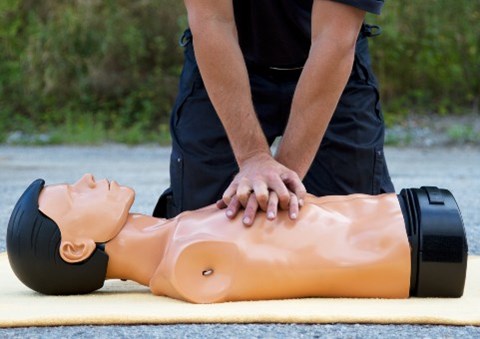‘I don’t want to put myself in harm’s way trying to help somebody': Public knowledge and attitudes towards bystander CPR in the North East and North Cumbria


‘I don’t want to put myself in harm’s way trying to help somebody’: Public knowledge and attitudes towards bystander CPR in the North East and North Cumbria.
Quick-read summary
Cardiac arrest is a life-threatening emergency. It occurs when the heart suddenly stops beating. This is different to a heart attack, which is where the heart is damaged but continues to beat. When the heart stops beating it cannot pump blood to the brain, lungs and other organs. Within seconds of a cardiac arrest, a person will become unconscious and unresponsive. When a cardiac arrest occurs in the community, outside of a hospital setting, it is called an out of hospital cardiac arrest (OHCA). It is an emergency that requires urgent treatment with immediate cardiopulmonary resuscitation (CPR).
CPR is where you press up and down on the chest of someone whose heart has stopped to keep their blood going around the body until the ambulance arrives. Members of the public have a vital role to play in improving someone’s chance of survival by recognising a cardiac arrest, calling for help, beginning CPR and fetching and using a publicly accessible defibrillator before the arrival of a paramedic.
Across England there is variation in the proportion of patients who receive bystander CPR (BCPR). North East England and North Cumbria are areas where rates of BCPR are lower than other parts of England, despite having a higher than average rate of OHCA. This aim of this research was to find out why this variation exists by collecting information (using questionnaires and interviews) from a variety of people across North East England and North Cumbria.
Who is this evidence useful for?
All members of the public across North East and North Cumbria, health and care professionals, policy makers.
What is the issue
Research summary
The North East Ambulance Service (NEAS) research team delivered a study to explore this topic further. The study involved a paper-based survey designed to capture information about the participant, their general health and their knowledge and experience of CPR and use of a public access defibrillator (PAD), willingness and competency to deliver BCPR and use a PAD, and how the Coronavirus pandemic has changed their willingness to help.
The NEAS research team visited locations across North East England and North Cumbria of varying levels of social deprivation and asked individuals to complete the survey. All participants who completed the survey were asked if they were willing to be interviewed to discuss their survey answers in more depth.
What the research found
603 individuals completed the survey, 20 of whom were interviewed. There was varied knowledge and understanding of OHCA and PAD function and use, which underpinned anxiety and fear surrounding the incorrect delivery of these interventions by bystanders. Over all, social deprivation was a poor indicator of knowledge of, and willingness and competency to perform, BCPR or use a PAD.
Other factors were more important:
Why is this important?
These findings are important because they provide additional insight into why individuals in our region may not deliver BCPR. The findings tell us that strategies targeted at population level are unlikely to improve rates of BCPR, and that a more targeted and tailored approach is required, directly involving communities of interest.
This has helped the research team at North East Ambulance Service to develop a new research project developing participant focussed BCPR initiatives, tailored to the specific needs of different groups of individuals. For instance, a group of people with ethnic diversity will have different needs to individuals who are disabled. There may also be different needs for groups who live in different places (have a different geography).
How were people/community groups/patients involved in this work?
The research team were keen to involve members of the public and community teams in the development and implementation of this research. Sunderland Cardiac Rehab group were very much an important part of this. The group were involved in all aspects of the study, from conception, delivery, data analysis and dissemination of findings. The group helped develop the survey and interview questions and we met regularly with them during the study to gain advice and support regarding any issues we encountered.
What’s next?
This work was funded via the NIHR ARC North East and North Cumbria Open Funding Competition 2020.
Lead researcher
Karl Charlton, Research Paramedic, North East Ambulance Service (NEAS)
Get in touch about this research
Read more below
I don’t want to put myself in harm’s way trying to help somebody: Public knowledge and attitudes towards bystander CPR in North East England – findings from a qualitative interview study. Published in Science Direct, December 2023
Public attitudes towards bystander CPR and their association with social deprivation: Findings from a cross sectional study in North England. Published in Resuscitation Plus (Science Direct) December 2022